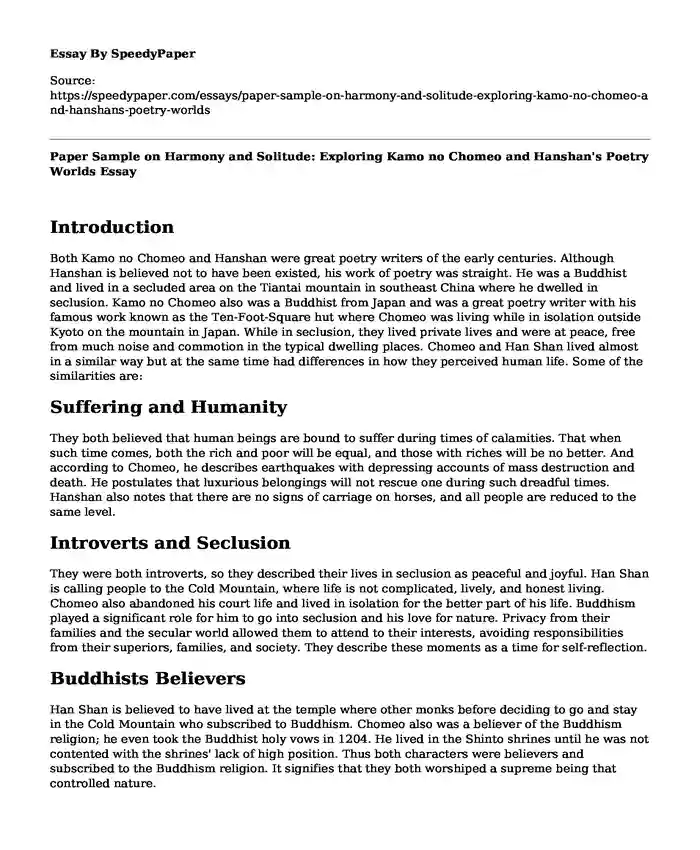
| Type of paper: | Essay |
| Categories: | Literature Family |
| Pages: | 3 |
| Wordcount: | 666 words |
Introduction
Both Kamo no Chomeo and Hanshan were great poetry writers of the early centuries. Although Hanshan is believed not to have been existed, his work of poetry was straight. He was a Buddhist and lived in a secluded area on the Tiantai mountain in southeast China where he dwelled in seclusion. Kamo no Chomeo also was a Buddhist from Japan and was a great poetry writer with his famous work known as the Ten-Foot-Square hut where Chomeo was living while in isolation outside Kyoto on the mountain in Japan. While in seclusion, they lived private lives and were at peace, free from much noise and commotion in the typical dwelling places. Chomeo and Han Shan lived almost in a similar way but at the same time had differences in how they perceived human life. Some of the similarities are:
Suffering and Humanity
They both believed that human beings are bound to suffer during times of calamities. That when such time comes, both the rich and poor will be equal, and those with riches will be no better. And according to Chomeo, he describes earthquakes with depressing accounts of mass destruction and death. He postulates that luxurious belongings will not rescue one during such dreadful times. Hanshan also notes that there are no signs of carriage on horses, and all people are reduced to the same level.
Introverts and Seclusion
They were both introverts, so they described their lives in seclusion as peaceful and joyful. Han Shan is calling people to the Cold Mountain, where life is not complicated, lively, and honest living. Chomeo also abandoned his court life and lived in isolation for the better part of his life. Buddhism played a significant role for him to go into seclusion and his love for nature. Privacy from their families and the secular world allowed them to attend to their interests, avoiding responsibilities from their superiors, families, and society. They describe these moments as a time for self-reflection.
Buddhists Believers
Han Shan is believed to have lived at the temple where other monks before deciding to go and stay in the Cold Mountain who subscribed to Buddhism. Chomeo also was a believer of the Buddhism religion; he even took the Buddhist holy vows in 1204. He lived in the Shinto shrines until he was not contented with the shrines' lack of high position. Thus both characters were believers and subscribed to the Buddhism religion. It signifies that they both worshiped a supreme being that controlled nature.
Differences in Attitude between Chomeo and Han Shan about human life
Family and Companionship
Whereas these two poets have many similarities, they also have differences in how they view human life. Chomeo has gone to the mountains away from family and the obligations of superiors to be alone. He describes this place as the most joyful place where he has self-reflection time. Although Han Shan also lives in the mountains, he has a beautiful lady to keep him company. Therefore, he values companionship instead of Chomeo, lonely in the Mountains with all that cold and bushes.
Self-sufficiency and Communism
Another difference is Mocheo seems to be advocating for self-sufficiency. He is warning that whenever you seek help from someone, that person will have control over you. He says poverty comes with hardships and suffering, whereas the wealthy could fear being attacked and robbed. Han Shan, on the other hand, believes in sharing among people. He condemns greed and stinginess and even wants them to be chased away in his poem. Han Shan thinks people should rely on one another, which is their true nature, and in line with Buddhism's teachings. He always tells those asking where he lives to come and see for themselves.
Conclusion
In conclusion, both Chomeo and Han Shan have played a significant role in their respective countries' poetry and literature development.
Works Cited
Hanshan, and Jerome P Seaton. Cold Mountain. Longhouse, 2003.
Houwen, Andrew. Thinking By Images: Kamo No Chomei's Hojoki And Basil Bunting's Chomei At Toyama. 2012.
Cite this page
Paper Sample on Harmony and Solitude: Exploring Kamo no Chomeo and Hanshan's Poetry Worlds. (2024, Jan 30). Retrieved from https://speedypaper.net/essays/paper-sample-on-harmony-and-solitude-exploring-kamo-no-chomeo-and-hanshans-poetry-worlds
Request Removal
If you are the original author of this essay and no longer wish to have it published on the SpeedyPaper website, please click below to request its removal:
- Free Essay Sample on Inspiration for Writers
- Poetry Essay Example: Themes in Poems by Bradstreet
- Frankenstein Narrative in a Free Essay Example
- New Jerusalem by William Blake, Free Essay with Poem Analysis
- Essay Sample: The Condition of Chinese Women in "The Field of Life and Death"
- Henry Personal Life. Free Essay Example
- Smart Shield: Stylish and Effective COVID-19 Protection for Children - Essay Sample
Popular categories




